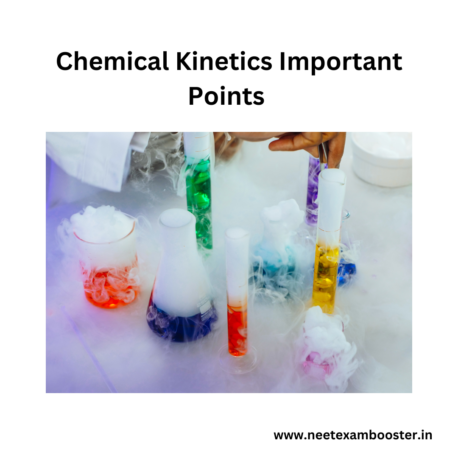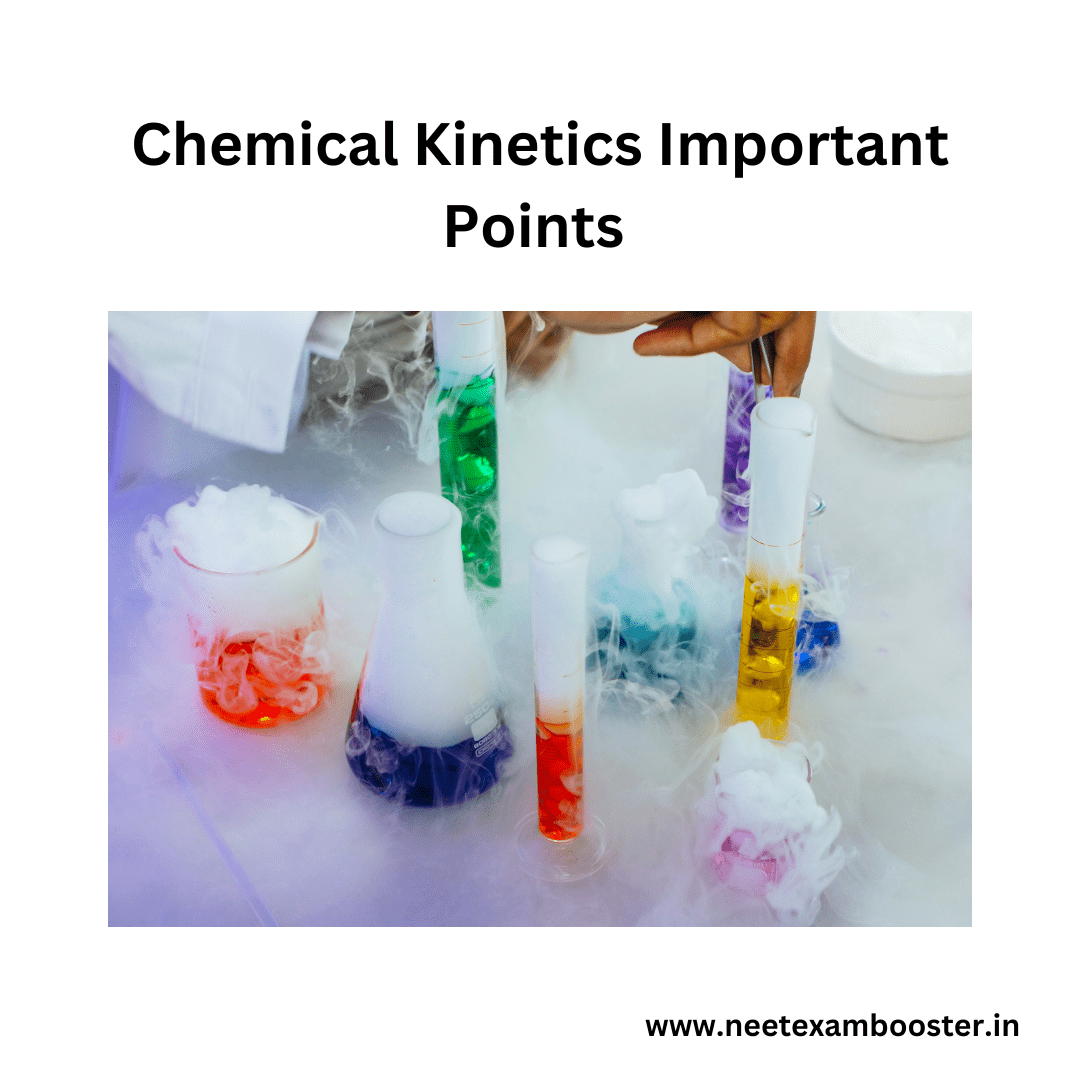Chemical Kinetics Important Points– Chemical kinetics is the branch of chemistry that studies the rates of chemical reactions and the factors that influence them. The rate of a reaction is the change in concentration of a reactant or product per unit time and can be affected by factors such as temperature, concentration, pressure, catalysts, and surface area. The rate law relates the rate of the reaction to the concentrations of the reactants and can be determined experimentally. The rate constant is a temperature-dependent proportionality constant in the rate law equation.
Activation energy is the minimum energy required for a reaction to occur, and catalysts lower the activation energy. The order of a reaction with respect to a reactant can be determined experimentally, and the half-life is the time taken for the concentration of a reactant to decrease to half of its initial value. Reaction intermediates and the rate-determining step help explain complex reaction mechanisms. The rate law for an elementary reaction is deduced directly from its balanced chemical equation.
Reversible reactions have rate laws involving forward and reverse rate constants, and the equilibrium constant relates to these rate constants. The rate of a reaction is highest at the start and gradually decreases as the reaction progresses. Inhibitors can decrease the reaction rate. Chemical kinetics has applications in various fields such as industry, environment, and pharmaceutical research.
Chemical Kinetics Important Points, Chemical Kinetics Important Points, Chemical Kinetics Important Points, Chemical Kinetics Important Points, Chemical Kinetics Important Points, Chemical Kinetics Important Points, Chemical Kinetics Important Points,

NCERT Chemistry Class 12 Chapter 4 – 25 Chemical Kinetics Important Points
There are 25 important points on chemical kinetics –
- Chemical kinetics is the branch of chemistry that deals with the study of the rates of chemical reactions and the factors that influence them.
- The rate of a chemical reaction is defined as the change in concentration of a reactant or product per unit time.
- The rate of a reaction can be expressed as the decrease in concentration of a reactant or the increase in concentration of a product with time.
- The rate of a reaction is affected by factors such as temperature, concentration of reactants, pressure, catalysts, and surface area.
- The rate law of a chemical reaction relates the rate of the reaction to the concentrations of the reactants.
- The rate law can be determined experimentally by measuring the initial rates of the reaction at different concentrations of the reactants.
- The rate constant (k) is a proportionality constant in the rate law equation and represents the rate of reaction when the concentrations of the reactants are unitary.
- The rate of a reaction can be determined using the rate law equation: Rate = k[A]^m[B]^n, where [A] and [B] are the concentrations of reactants A and B, and m and n are the reaction orders with respect to A and B, respectively.
- The overall reaction order is the sum of the individual reaction orders and determines how the rate of reaction changes with concentration.
- The rate constant is temperature-dependent and can be determined using the Arrhenius equation: k = Ae^(-Ea/RT), where k is the rate constant, A is the pre-exponential factor, Ea is the activation energy, R is the gas constant, and T is the temperature in Kelvin.
- The activation energy (Ea) is the minimum energy required for a reaction to occur and determines the reaction rate.
- Catalysts are substances that increase the rate of a chemical reaction by providing an alternative reaction pathway with a lower activation energy.
- The presence of a catalyst does not affect the overall reaction stoichiometry.
- The order of a reaction with respect to a particular reactant can be determined experimentally by the method of initial rates or by the method of integrated rate equations.
- The half-life of a reaction is the time taken for the concentration of a reactant to decrease to half of its initial value.
- The half-life of a reaction is inversely proportional to the rate constant.
- The concept of reaction intermediates helps explain complex reaction mechanisms.
- The rate-determining step is the slowest step in a reaction mechanism and determines the overall rate of the reaction.
- The rate law for an elementary reaction is deduced directly from its balanced chemical equation.
- The rate of a reaction can be expressed in terms of the change in concentration of reactants or products with time.
- The rate law for a reversible reaction can be expressed in terms of the forward and reverse rate constants.
- The equilibrium constant (Kc) for a reversible reaction can be related to the forward and reverse rate constants.
- The rate of reaction is maximum at the start of the reaction and gradually decreases as the reaction progresses.
- The rate of reaction can be influenced by the presence of inhibitors, which decrease the reaction rate.
- Chemical kinetics plays a crucial role in various fields such as industrial processes, environmental studies, and pharmaceutical research.
Some Important Questions From Biology Class 11
| Chapter Name | Quiz Link |
| The Living World | Play Now |
| Biological Classification | Play Now |
| Plant Kingdom | Play Now |
| Animal Kingdom | Play Now |
| Morphology of flowering plants | Play Now |
| Anatomy of flowering plants | Play Now |
| Cell: the unit of life | Play Now |
| Biomolecules | Play Now |
| Cell Cycle and cell division | Play Now |
| Transport in Plants | Play Now |
| Structural organisation in Animals | Play Now |
| Mineral nutrition | Play Now |
| Photosynthesis in higher plants | Play Now |
| Respiration in plants | Play Now |
| Plant Growth and development | Play Now |
| Digestion and Absorption | Play Now |
| Breathing and Exchange of Gases | Play Now |
| Body fluids and circulation | Play Now |
| Excretory products and their elimination | Play Now |
| Locomotion and Movement | Play Now |
| Neural Control and Coordination | Play Now |
| Chemical Coordination and Integration | Play Now |
Some Important Questions From Biology Class 12
| Chapter Name | Quiz Link |
| Reproduction in organism | Play Now |
| Sexual reproduction in flowering plant | Play Now |
| Human reproduction | Play Now |
| Reproductive health | Play Now |
| Principles of inheritance and variation | Play Now |
| Molecular basis of inheritance | Play Now |
| Evolution | Play Now |
| Human health and disease | Play Now |
| Strategies for enhancement in food product | Play Now |
| Microbes in human welfare | Play Now |
| Biotechnology principles and processes | Play Now |
| Biotechnology and its application | Play Now |
| Organism and population | Play Now |
| Ecosystem | Play Now |
| Biodiversity and its conservation | Play Now |
| Environment issue | Play Now |



















